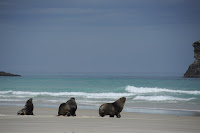One of the natural attractions of the Dunedin area is the Otago peninsula which sits just east of the city and it surrounded by waters rich in marine life- seals and sealions, penguins and albatross. We drive out to Sandfly Bay
towards evening because we've read that the endangered yellow eyed penguins, whose population today stands at only 300, make their nightly journey up the beach and over the dunes to their nests and it's quite a spectacle. The Department of Conservation have built a viewing hut for this specific purpose because the penguins are very shy creatures and will not come ashore is they see people on the beach. This could be fatal for their little chicks because they'll go hungry. At this time of year though the eggs are being incubated by the mother and the male penguin comes ashore to relieve his mate and take over the duty. We wait in the hut for a significant amount of time and the light starts to fail and then, sure enough, a penguin swims ashore and starts waddling and jumping over the rocks on the beach. He then proceeds to clamber his way slowly up the tussock covered hillside to the very top where he enters his nest and his mate comes out in his place. We wait again for any more but eventually give up and head back along the beach, which is incidentally dotted with gigantic snoozing sealions. .JPG)
It's important not to get too close these big daddies as they have an awesome jaw strength and can move very quickly across the sand when they want to. We spot a couple more penguins swimming but we choose to leave the beach briskly in case they're too frightened to come ashore.
.jpg)
.jpg)
.jpg)
.jpg)
.jpg)
.jpg)
.jpg)
.jpg)
.jpg)
.jpg)
.jpg)
.jpg)
.jpg)
.jpg)
.jpg)

